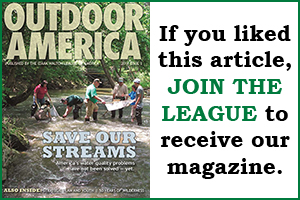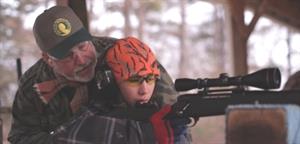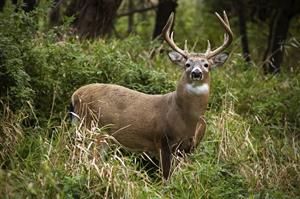Introducing someone to the thrill and beauty of hunting starts with one simple question. “How would you like to go deer hunting with me this fall?” I asked Doak Harbison, a fellow teacher at Virginia’s Lord Botetourt High School, one day in September.
“You know, Luke [a high school freshman] has been asking me the past few years about taking a hunter safety class and us going hunting,” said Doak. “But we’ve both been so busy with my teaching and his homework and extracurricular stuff on Saturdays that I haven’t had time to check into it. I just didn’t know where to start.”
“Tell you what,” I replied. “You guys take that class, and I’ll take you deer hunting in November during the two-week firearms season and then take Luke and you squirrel hunting when we’re all off from school over the Christmas holidays. Then next year, the three of us can go deer hunting together, and you can help me mentor Luke, since you’ll have had some experience by then.” Doak was excited about the prospect of hunting with me and asked questions about everything from guns to gear.
“You guys can come over to my house and do some target shooting,” I suggested. “And I’ll start making a list of the gear you will need.”
The number of hunters in the United States grew 9 percent between 2006 and 2011, according to data from the U.S. Fish and Wildlife Service. However, these gains have not erased decades of losses. Total hunting participation is still below 1996 (and earlier) levels, and hunter numbers continue to stagnate or decline in many states.
Ikes who are experienced hunters can help reverse this trend. By introducing friends and acquaintances to hunting — and showing them how to access lands for it — we can play a positive role in connecting adults and young people with our outdoor sports.
Need for New Hunters
Hunting is more than a sport; it’s an important part of the U.S. economy. In 2011, hunters spent $34 billion on trips, equipment, licenses, and other items to support hunting activities, according to the Fish and Wildlife Service’s “2011 National Survey of Fishing, Hunting, and Wildlife-Related Recreation.” Much of that spending occurs in rural communities, where hunters pay for food, lodging, gas, guides, and more. America’s hunters support an estimated one million jobs in this country.
 They also support fish and wildlife conservation. An excise tax of 11 percent on all firearms and archery equipment and ammunition is used to fund conservation work across the nation. That has added up to more than $6.5 billion in conservation funding since 1937. However, decreases in hunter numbers jeopardize funding for a wide range of natural resource conservation.
They also support fish and wildlife conservation. An excise tax of 11 percent on all firearms and archery equipment and ammunition is used to fund conservation work across the nation. That has added up to more than $6.5 billion in conservation funding since 1937. However, decreases in hunter numbers jeopardize funding for a wide range of natural resource conservation.
We must act now to increase the ranks of new hunters across America, particularly youth. According to Families Afield — an initiative to create hunting opportunities for youth — for every 100 adult hunters today, only 69 youth hunters are coming up to take their places. Despite an increase in adult hunters for the first time in decades, the number of youth hunters barely inched up between 2006 and 2011.
“The hunter recruitment rate is abysmal,” says Tom Hughes, assistant vice president for education and outreach for the National Wild Turkey Federation and the group’s representative for Families Afield. “All of us sportsmen need to take our hunting destiny into our hands and personally do something to grow our pastime.”
Folks can become anglers as long as they obtain a rod and have access to a farm pond or stream. They can become birders with a pair of binoculars and a field guide. They typically can’t become hunters, though, without a mentor, and that’s why we need to be more proactive about introducing someone to hunting. The first question is with which game animal.
Big Game or Small Game
Tom Hughes began his hunting career chasing after small game such as squirrels and rabbits and believes that is still the best way to start.
“If an adult or child messes up while hunting a squirrel, it’s not a traumatic experience,” says Hughes. “There’s a lot more action with squirrels, rabbits, and doves, and new hunters don’t have to be so quiet. In my opinion, there’s a big place for small game in the hunter orientation process, especially for kids.”
“On the other hand,” Hughes continues, “it’s not a bad thing that the first game animal someone pursues is a deer. I would recommend that the new hunter start with a rifle or a shotgun instead of a weapon such as a bow. It’s important for a beginner to experience some success while afield, and all the practice and skills that have to be developed for someone to become a successful bowhunter can take several years.”
I asked Doak Harbison if he wanted to start hunting by going after squirrels and he flatly rejected that scenario. However, Doak said he was excited and intrigued by the notion of bringing home meat for his family. To introduce the Harbisons to venison, I brought venison stew and soup dishes to school for Doak and Luke to try. Then my wife, Elaine, and I had them over for lunch one Sunday, and we dined on one of my favorite repasts: deer burgers topped with sharp cheddar cheese. In just a few bites, they were hooked — and ready for hunting season.
Firearms for First-Timers
 It was time to help Doak purchase his first deer gun. Chris Walls — who operates the popular West Virginia program, Beyond the Backdoor, which is designed to create enthusiasm for the outdoors among youngsters — offered advice on arming new hunters. “There’s no question that a 12-gauge shotgun is the best first gun for a beginning adult hunter,” says Walls. “For sure, they’ll need practice time, but they won’t have to spend hours at a range sighting in a rifle or muzzleloader. Plus, that individual could use that same gun to eventually turkey hunt or go after small game.”
It was time to help Doak purchase his first deer gun. Chris Walls — who operates the popular West Virginia program, Beyond the Backdoor, which is designed to create enthusiasm for the outdoors among youngsters — offered advice on arming new hunters. “There’s no question that a 12-gauge shotgun is the best first gun for a beginning adult hunter,” says Walls. “For sure, they’ll need practice time, but they won’t have to spend hours at a range sighting in a rifle or muzzleloader. Plus, that individual could use that same gun to eventually turkey hunt or go after small game.”
I helped Doak pick out a used 12-gauge autoloader. Then he and Luke came over to my house for some target practice and safety instruction in addition to what they had received in their hunter safety classes. Doak told me that despite having taken the class, he was still a little confused about how to load his new gun, so we went over how to safely do so. Then it was time for the shooting lesson to begin. (We own 38 wooded acres surrounded by farmland, and I use an area with a thick berm backed by a woodpile.)
As Doak prepared to shoot, I noticed that his elbows were “flared” — that is, not resting on his knees. Predictably, as we examined the target, he was disappointed about the shot pattern. I showed him how to rest his elbows on his knees, and his second shot pattern was very tight.
After watching and learning from his dad’s error, Luke peppered the center of the target, which brought a grin to the young man’s face and some good natured teasing of his dad. We discussed maximum shooting range for a shotgun fueled with buckshot (about 40 yards) and I showed them how to use my rangefinder.
We then walked down into a hollow where I had killed numerous deer over the years. Elaine and I asked Doak and Luke to analyze the terrain and predict where and from which direction whitetails might enter the hollow and where hunters might take a stand to take advantage of deer travel patterns. Understandably, the twosome did not understand the concept of funnels and game trails at first, but they eventually did so. Next, we visited stands of white and red oaks and discussed tree and acorn identification and other deer food plus deer signs such as rubs, scrapes, and droppings — a good lesson in woodsmanship. Finally, we went inside and went over essential gear, from knives to clothing.
Gearing Up
Coming from a non-hunting suburban family, I did not start hunting until I was 33 and had no mentor. On one of my first deer hunts, I recall going afield clad in blue jeans, tennis shoes, and a nylon windbreaker on a day that brought heavy rain and temperatures in the 30s. After about an hour of that — and in the early stages of hypothermia — I skulked back to the car. I was determined to keep Doak and Luke from similar misery.
It is critical for veteran sportsmen to tutor novice hunters on the correct clothes to don, says Mike Andrews, vice president of marketing for clothing company Scent-Lok. “I still see and hear stories of too many hunters who wear cotton or jeans, and that type of clothing can kill in cold, rainy conditions. As a first outfit for a new hunter, every hunting clothing company offers a medium weight pant and jacket that can be adapted to warmer or cooler weather by adding or taking away layers of underwear. Instead of cotton, I would recommend underwear made from wool, synthetics like polyester or acrylic, or wool and synthetic blends.”
Andrews explains that the next consideration is how the clothing smells. “Many new hunters don’t understand that controlling their scent is crucial to success, and mentors definitely need to stress how well whitetails can smell. New hunters should be told not to wash their clothes in regular detergent, how to properly store their clothes in scent-free containers or bags, and the importance of wearing clothes that are as free of human scent as possible.” That could make the difference between spooking a deer and getting close enough for a clean shot.
Hunting Deer with Doak
 On Virginia’s opening day of firearms season, I took Doak to a farm where I have permission to hunt. Here the deer numbers are very high and the landowner has requested that I kill does and let bucks walk unless they are mature and sport a minimum of eight points.
On Virginia’s opening day of firearms season, I took Doak to a farm where I have permission to hunt. Here the deer numbers are very high and the landowner has requested that I kill does and let bucks walk unless they are mature and sport a minimum of eight points.
Despite the property’s pedigree, we didn’t spot a whitetail the entire time we were there. Nevertheless, Doak and I discussed numerous topics during our six hours afield: effective shooting range of his shotgun, what species of birds visited our setup (yellow-rumped warblers), what species of hawk flew overhead (Cooper’s hawk) and what was it doing (probably hunting the aforementioned warblers and other birds), why didn’t we see any deer (it’s a part of hunting), and, most importantly, when could we go again (Tuesday after school).
We also talked about how to gain permission to hunt, and I suggested everything from knocking on doors in rural areas to making contacts at the workplace and in the community. I added that Virginia, like many states, has extensive public lands in the form of state wildlife management areas, a national forest, and state-owned forest land. I also told him that my wife always bakes homemade bread for any landowner on whose land I kill a deer or turkey and that, before the season starts, I go over a landowner’s preferences on when I should come, whether he wants me to notify him before I come, and the age and sex of the deer that can be harvested. Over the course of Virginia’s firearms and late muzzleloader seasons, I took Doak deer hunting 10 times. Frustratingly for him and me, he was never able to kill a whitetail. Perhaps the most maddening outing for us occurred on the nextto- the-last day of the firearms season. After we left school, we quickly drove to a nearby cattle farm and walked toward a stand site where we had observed whitetails the day before. At the stand site stood three deer, which, of course, spooked when they glimpsed us.
Talking Turkey with Luke
I planned to take Luke afield for squirrels first, but Virginia’s fall turkey season happened to coincide with our squirrel hunt — and things got interesting. I had given the ninth grader a turkey box call to play with, and the third time he made sounds with it, a turkey answered in the distance.
Doak, Luke, and I continued our squirrel hunt — focused on an actively foraging gray we’d been stalking — when the flock we heard earlier began yelping only about a hundred yards away. I asked Luke which he wanted to pursue and he gave a succinct answer: “The turkeys, right now.” I had explained to Luke that turkey hunters often scatter fall flocks to separate the group, and then call individuals back in. So with my two new hunters in tow, I led the charge into the gang. Some 20 turkeys took to the air in four different directions — a perfect bust.
“That was exciting!” Luke exclaimed.
“What do we do now?” Doak inquired. I told them that we would set up and try to call in the turkeys. Luke made yelps with his box while I uttered kee-kees on a diaphragm. Three turkeys ventured in unannounced on Doak’s blind side, saw the three of us, putted in alarm, and departed.
“What did I do wrong?” asked Doak. The obvious answer, from anyone who has ever chased these unpredictable birds, was “nothing.”
“It’s just turkey hunting,” I said.
I was not able to help Doak or Luke kill a game animal in their initial season afield. But on the way home, Doak and Luke made plans to go to a range to practice their shooting skills, made a checklist of more gear they needed, and asked me to take them spring gobbler hunting.
I enjoyed going afield with this father and son team — both for the time spent outdoors and for the contribution made to their futures as outdoorsmen. I am confident that these men will continue to build a deep appreciation for the natural world and, eventually, come home with that gobbler.
Consider asking someone you know to go hunting with you this year. The future of the outdoor pursuits we love depends on it.